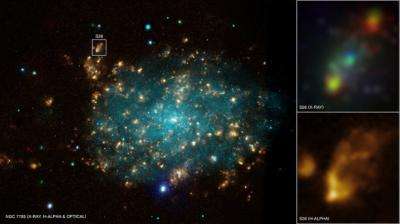Image: Black Hole Blows Big Bubble

This composite image shows a powerful microquasar produced by a black hole in the outskirts of the nearby (12.7 million light years) galaxy NGC 7793. The large image contains data from the Chandra X-ray Observatory in red, green and blue, optical data from the Very Large Telescope in light blue, and optical emission by hydrogen ("H-alpha") from the CTIO 1.5-m telescope in gold.
The upper inset shows a close-up of the X-ray image of the microquasar, which is a system containing a stellar-mass black hole being fed by a companion star. Gas swirling toward the black hole forms a disk around the black hole. Twisted magnetic fields in the disk generate strong electromagnetic forces that propel some of the gas away from the disk at high speeds in two jets, creating a huge bubble of hot gas about 1,000 light years across. The faint green source near the middle of the upper inset image corresponds to the position of the black hole, while the red (upper right) and yellow (lower left) sources correspond to spots where the jets are plowing into surrounding gas and heating it. The nebula being illuminated by the jets is clearly seen in the H-alpha image shown in the lower inset.
The jets in the NGC 7793 microquasar are the most powerful ever seen from a stellar-mass black hole and the data show that a surprising amount of energy from the black hole is being released by the jets, rather than by radiation from material being pulled inward. The power of the jets is estimated to be about ten times larger than that of the very powerful ones seen from the famous microquasar in our own galaxy, SS433. This system in NGC 7793 is a miniature version of the powerful quasars and radio galaxies seen in more distant galaxies, which contain black holes that range from millions to billions of times the mass of the sun.
A paper describing this work is being published in the July 8th, 2010, issue of Nature. The authors are Manfred Pakull from the University of Strasbourg in France, Roberto Soria from University College London, and Christian Motch, also from the University of Strasbourg.
Provided by JPL/NASA





















